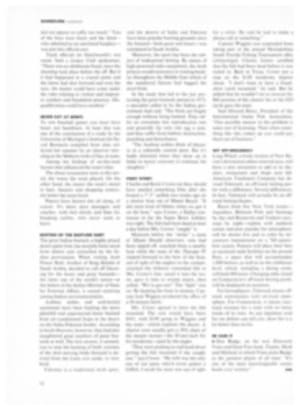
AN ODD WAY TO EVEN THINGS UP
According to thefearful administrators of intercollegiate sport, a crisis of "unprecedentedmagnitude" has been dumped on them by the federal government. They claimthat this momentous crisis, if unrelieved, will strangle the financing ofintercollegiate competition and lead to its demise.
At issue are theguidelines laid down by the U.S. Department of Health, Education and Welfarefor the enforcement of Title IX, the 1972 act that forbids sex discriminationin any educational institution receiving federal funds—in other words, justabout every college and university in the country. HEW, as Title IX'sinterpreter, is required by Congress to deny funds to institutions notcomplying with the statute.
Title IX was notoriginally written with sports in mind, but in the '70s activists for women'sathletics made the statute applicable to sports. Subsequent attempts to clarifywhat Title IX meant as far as intercollegiate sports programs are concernedwere so vague that college athletic administrators were puzzled. Nevertheless,women's participation in college sports has more than doubled this decade. Ithas grown with such speed that, according to HEW, women now constitute 26% ofthe total number of college athletes, and 18% of the total collegiate budgetdollar is spent on women. This is undoubtedly a result of Title IX, even thoughthe procedures for compliance weren't spelled out.
In the six yearssince Title IX became law, there has been debate over exactly how a school issupposed to avoid sex discrimination in its athletic program. For example, if aschool spends $100,000 on men's sports, does Title IX mean it must spend$100,000 on women's sports? If it pays its men's basketball coach $30,000 ayear, must it pay its women's basketball coach the same amount? Such questionsshould have been answered last July, the original deadline for compliance withTitle IX. They were not answered, and until the end of the year, a spirit oflaissez-faire prevailed.
Then the bombfell.
Last December, amonth before the NCAA's annual convention in San Francisco, HEW SecretaryJoseph Califano issued a 35-page "clarification" of the guidelines thathad been proposed in 1975 and were to go into effect last July. In addition tosetting a new deadline for compliance—the start of the 1979-80 school year—thedocument included an apparently logical policy formula requiring that"expenditures on men's and women's athletics be proportional to the numberof men and women participating..." and that they be "substantiallyequal" on a per capita basis. As HEW Staff Attorney Jean Peelin explainedit at the convention. "If a college has 200 male varsity athletes andspends $200,000 on scholarships for an average of $1,000 per scholarship permale athlete, that college must spend an average of $1,000 on athleticscholarships for women."
According to thecollege administrators, that formula alone would present obvious and numerouspitfalls to anyone who ever tried to balance an athletic budget. But whatscared them most was that Califano's "clarification" specified that thecolleges had to include football and basketball in the formula, and that therevenues of these sports could not be counted against their expenditures.Example: State College spends $250,000 on its basketball program. Thebasketball program brings in a profit of $100,000. The college administratorswould like to subtract the profit from the expenditure. HEW says no dice, theexpenditure of $250,000 must be the figure the school uses when it calculateshow much it spends per male athlete in order to determine how much must bespent per female athlete. By way of alleviating this fear, HEW does say it willtake into account the exceptionally high cost of certain sports, for instance,football. But the administrators weren't mollified.
In San Francisco,Peelin further said the HEW staff had been instructed by Califano to say nomore about the guidelines until after Feb. 10, the deadline for the colleges to"comment" on the HEW proposals. But she said it was understood that thepolicy would have an open end, that whenever a women's team was added—or awoman was added to a team—the per capita formula would apply. This, she said,was in keeping with Califano's guideline synopsis, which specifies thatcolleges and universities "take specific active steps to provide additionalathletic opportunities for women."
Although Califanostated that the interpretation "recognizes that intercollegiate football,in particular, is unique among sports," and that "reasonable provisionsconsidering the nature of a particular sport" would have to be taken intoaccount, by the time the college administrators hit San Francisco, they were inno mood for what one representative called "vague assurances." Most ofthem, in fact, were at a loss to explain what they considered HEW's continualwaffling. Tom Hansen, the NCAA's assistant executive director, said, "Whenyou start understanding them [the guidelines] is when you really getscared."
Stirred up by animpassioned keynote speech against HEW by Dr. William E. Davis, president ofthe University of New Mexico, the delegates forecast doom all around. Theycalled the proposals an "illegal power grab" by HEW, and Davis said,"A crisis of unprecedented magnitude is coming." He charged the federalgovernment with "trying to become the fifth man in the Notre Damebackfield."
In an almostunanimous resolution the delegates charged that the HEW formula was"unrealistic and unworkable." They credited themselves with"massive new allocations of resources to their women's programs" andsaid that they were going to get "judicial determination" because HEW"does not have regulatory authority over intercollegiate sports programswhich are not federally assisted." They charged that the guidelinesconstituted an incursion "upon the autonomy of institutions," and vowedto see their Congressmen.
Theseadministrators say they are terrified because they feel the options left tothem are not only budget-busting, but also acceptable only to those who want tosee big-time football and big-time basketball put in their places. Which is tosay de-emphasized, if not eliminated. Every solution, they claim, is aneconomic monstrosity. These include:
1) Bring thewomen's program to scratch by simply shoveling in the necessary funds.Ironically, some of the football giants could probably do this without pinchinga penny. Alabama football not only funnels vast sums into the athleticdepartment (and a seven-sports women's program), but it also makes annualdonations to the general fund—including $500,000 one year for professors'salaries. UCLA Chancellor Charles Young says if would cost his school only$250,000 to achieve fiscal parity of the sexes, and sees it as no problem. Forthe majority of colleges, however, $250,000 is a mother lode. For those on thehairy edge, says San Jose State Athletic Director Bob Murphy, "even $5,000is a small fortune."
2) Reduce themoney spent on men's football and basketball. There is no doubt that more"extras" are provided in those sports than are necessary. Footballrecruiting costs are obscene. The rub is that when Team A cannot keepreasonably close to Team B's budget, its ability to compete deteriorates, andthat in turn reduces its revenue potential. Many schools make enough money fromfootball to fund their entire athletic programs. In the future the money willhave to be found elsewhere.
3) Eliminaterevenue sports and fund everything else through student fees. This woulddestroy intercollegiate sport as we know it. It would also, of course, decreasesports opportunities for women.
So the solutionsseem not to be solutions at all to the administrators, who, of course, fear theworst. And they say many other questions have been left unanswered. If, forexample, there are no stipulations as to the level of skill of play (and thereare none in the guidelines), how do you turn away 10 girls who decide oneafternoon that they are a judo team? (Of course, HEW could well say how do youturn away 11 boys who decide they are a field hockey team?) Given theimportance of good coaching, how can you pay a women's coach less (as itappears is allowed by the guidelines) without athletes claiming that you havegiven them less?
On the other hand,Margot Polivy, an attorney for the Association of Intercollegiate Athletics forWomen, said last week that her group considers HEW's per capita formula"rational, reasonable, effective and workable."
If that sounds asif the battle lines are drawn, you have decoded the message. President Davissays, "I think Mr. Califano was hoping for a plan that would help womenwithout dismantling the men's program. I still think this is his objective. Theproblem is, for the women, equal is equal."
Father EdmundJoyce, the vice-president of Notre Dame, offered one alternative to the percapita formula: that HEW count the revenue from football and spread the profitsequally among the other men's and women's sports, or if there is a loss, countthat as an expenditure and include it in the cost breakdown.
No sale, saysPolivy. "Expenses would rise to meet the revenue every time," she says,implying that intercollegiate budget makers are not to be trusted. She says."There simply is no way to justify Michigan spending $400,000 to send itsfootball team to the Rose Bowl," and that big-time football is"anathema" to the educational system.
To date, HEW hasnot denied any college a nickel for failing to comply with Title IX. But comeSeptember, it is obliged by law to do just that. And as one universityspokesman said in San Francisco, "Once government starts administering, ittends to get adamant as hell, whether it's right or wrong."
ILLUSTRATION

